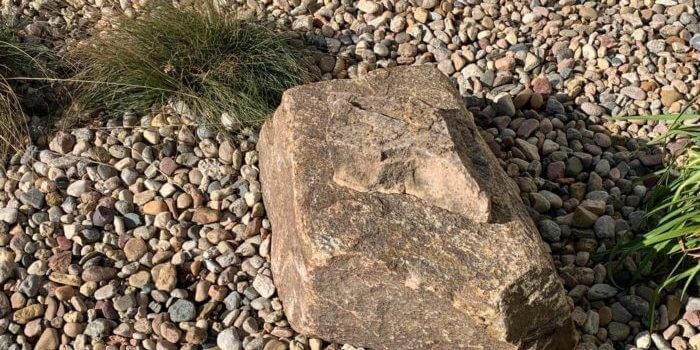() Sandia National Laboratories is working with New Mexico-based CSolPower LLC to make an affordable energy storage method from renewable sources—rocks.
The partnership aims to aid in the transition to zero-carbon solar and wind energy for electricity generation.
“You need to have energy storage and dispatchable power when renewable energy is unavailable or when there’s a large spike in demand from the grid,” Luke McLaughlin, a mechanical engineer at Sandia who works on thermal energy storage, said.
“With this project, we’re integrating renewable energy sources into an electrically charged thermal energy storage system,” McLaughlin added. “Our aim is to develop the technology and take it to a place where you can use wind and photovoltaic energy sources to charge the system.”
The Technology Readiness Gross Receipts initiative is paying for this phase of the project at up to $150,000 a year according to the Sandia web site.
Sandia’s Technology and Economic Development Department helps administer this tax-funded program. It allows eligible New Mexico businesses to collaborate with scientists and engineers from Sandia and Los Alamos national laboratories.
It is unclear to what extent Sandia may be receiving additional federal government incentives to conduct its research into garden rocks.
Watchdogs have noted recently that the Biden administration’s green-energy incentives have been ripe for fraud—much like the Obama administration, with its Solyndra scandal and other phony green-energy companies that Democrat cronies effectively used to launder tax-dollars to their personal coffers while avoiding normal regulations and oversight.
Sandia, which also is in charge of designing some of the U.S.’s nuclear weaponry, made national news in 2020 following an exposé from investigative journalist Christopher Rufo that detailed its efforts to brainwash white, male employees into embracing a woke mindset—during a taxpayer-funded company retreat that took place during the Trump administration.
The federal government's premier nuclear research lab hosted a 3-day reeducation camp for "white males," with the goal of exposing their "white privilege" and deconstructing "white male culture."
Here are the leaked documents from the race-segregated, taxpayer-funded session.👇
— Christopher F. Rufo ⚔️ (@realchrisrufo) August 12, 2020
But wokeness aside, the lab’s research also has the potential to become a game-changer for cost-effective and environmentally sustainable home-energy needs with oil prices expected soon to hit uncharted territory amid rising tensions in the Middle East.
That could be the tipping point that turns renewable green-energy into a commercially viable option on the free market, provided the supply is able to meet the demand enough to keep it affordable and reliable.
Sandia’s system features rocks held in a bed to be heated or cooled with air to store thermal energy.
“We’ve learned that gravel from landscaping companies can be successfully used for the system without requiring extensive washing or preparation,” Nathan Schroeder, a Sandia mechanical engineer, said in a release.
To test the rock bed’s performance at the National Solar Thermal Test Facility, Sandia designed a small 100-kilowatt-hour test rig.
Updates have been made, and photovoltaic panels are being installed to show the bed’s ability to charge using an intermittent energy source.
“One of the advantages of thermal energy storage in rocks is that it can be built anywhere,” Walter Gerstle, who co-founded CSolPower in Albuquerque in 2019, said.
“It can be commodified and doesn’t require extensive permitting,” Gerstle added. “We believe it can be implemented more quickly and economically than other approaches.”
Cost is a barrier to this type of energy.
“Reducing the cost of this thermal energy storage system, or energy storage systems in general, increases the potential for deploying these systems in industry, and it increases the likelihood of adopting renewable energy,” Schroeder said in the release.
CSolPower’s technology largely focuses on long-duration energy storage. This means it can provide energy storage ranging from hours to months.
When testing, the bed was charged with air at temperatures exceeding 900 degrees Fahrenheit. The system maintained that temperature for up to 20 hours.
“We successfully charged and discharged the system, and so far, the performance of the system is in line with our predictions and modeling,” Schroeder said.
Researchers hope the technology will help reduce dependence on fossil-fuel heat sources.
“A natural approach is to store excess electricity generated during the day as heat and then use it to heat water and homes at night,” Gerstle said in the release. “This is an example of the small-scale use of this storage option.”
They will continue prototype testing until June 2024.
“Our goal is to take this lab-scale project and prepare it for deployment in the marketplace,” Schroeder said.
CSolPower wants to make its technology ready for utility-scale storage. However, it plans to start with small-scale implementation. If the current testing phase is successful, several greenhouses in northern New Mexico want to use the rock bed for thermal energy storage.
“Instead of curtailing solar energy production, we would store it and use it during cold nights to keep the greenhouses warm enough to grow plants year-round,” Gerstle said.

